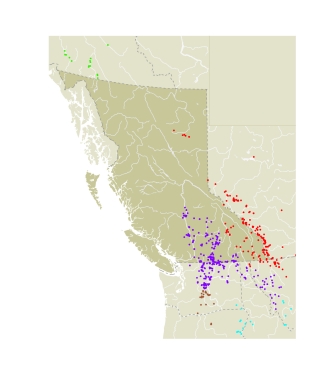The name Euphydryas is derived from the Greek euphys (a goodly shape) and dryas (a dryad or wood nymph) (Emmet 1991), hence these checkerspots are goodly shaped wood nymphs. The common name "checkerspots" is derived from the checkerboard pattern of the upperside of the wings.
The Euphydryas checkerspots differ from Charidryas checkerspots by having brick red, not tawny, spots alternating with the black spots. The male genitalia lack the saccus. This is a Holarctic genus, with five Nearctic species and four Palearctic species. None of the individual species are Holarctic. The larvae feed on a variety of plants. Adults of three western North American species, all of which are in BC, are very hard to distinguish without reference to the male genitalia. These three species are in the subgenus Euphydryas (= Eurodyras Higgins = Occidryas Higgins). The fourth BC species, E. gillettii, is in the subgenus Hypodryas. All species worldwide are in one or the other of the two North American subgenera.
The figure illustrates the one part of the male genitalia, the harpe, that is diagnostic for species. The short arms of the harpe, one rounded and toothed and the other flattened out, are diagnostic for the subgenus Hypodryas. In the subgenus Euphydryas, at least one arm of the harpe is longer than the body of the harpe. This subgeneric classification is supported by recent DNA analysis of worldwide Melitaeinae by Zimmermann et al. (2000), who prefer subgenera to genera. Once this paper has been examined closely, however, others may choose to recognize two genera instead of one for the North American fauna.
|
|

